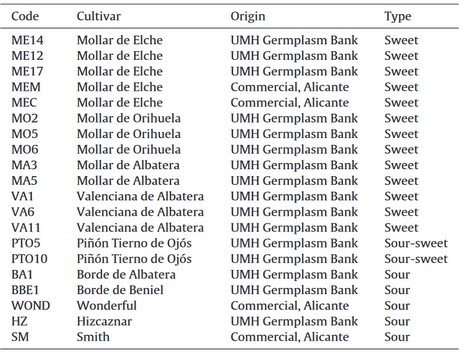Researchers from the Miguel Hernandez University in Alicante found significant chemical, physical and organoleptic differences in 20 Spanish cultivars.
Code, cultivar, orign and type (sweet, sour, sour-sweet) of the 20 cultivars of Spanish pomegranate analysed in this study.

As regards the aryls, the highest concentration was: 2.85% of crude fibre (BA1), 1.19g/100g of dry weight of potassium (PTO5), 15.9 ad 15.5 g/100mL of total sugars (SM and VA1 respectively), 4.89 g/100mL of total acids (SM); 1791mg GAE/100g of dry weight of total polyphenols, (BBE1); 4.24 mmol Trolox/kg of fresh weight of ABTS antioxidant activity (MEC); 7.74 mmol Trolox/kg of fresh weight of DPPH antioxidant activity (MO6). As regards the organoleptic characteristics, BA1 and BBE1 stood out for the hardness of their seeds, WOND and SM for the colour of the aryls and ME12, MEM and MEC for their sensory score.
"This characterisation has the aim of defining how to best use each fruit, from fresh consumption to juice making. This study identified the most suitable cultivars for fresh consumption as well as those most suitable for the processing industry. Cultivars with tender seeds and high sweetness levels are perfect for fresh consumption (ME12, ME14, MO5 and MA3), while those with a deep red colour and hard seeds can be destined to the processing industry (WOND and SM). Cultivars with a high content of total polyphenols (BBE1, ME12), antioxidant compounds (MEC, MEM, MO6 and PTO10), crude fibre (BA1 and BBE1) and minerals such as potassium (MEM, VA1, BA1 and SM) can be used in the medicinal or cosmetic fields and can be considered sources of natural fibres and antioxidant to develop or improve other functional food."







